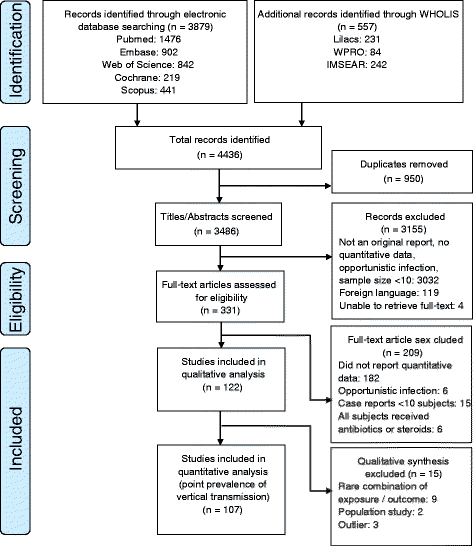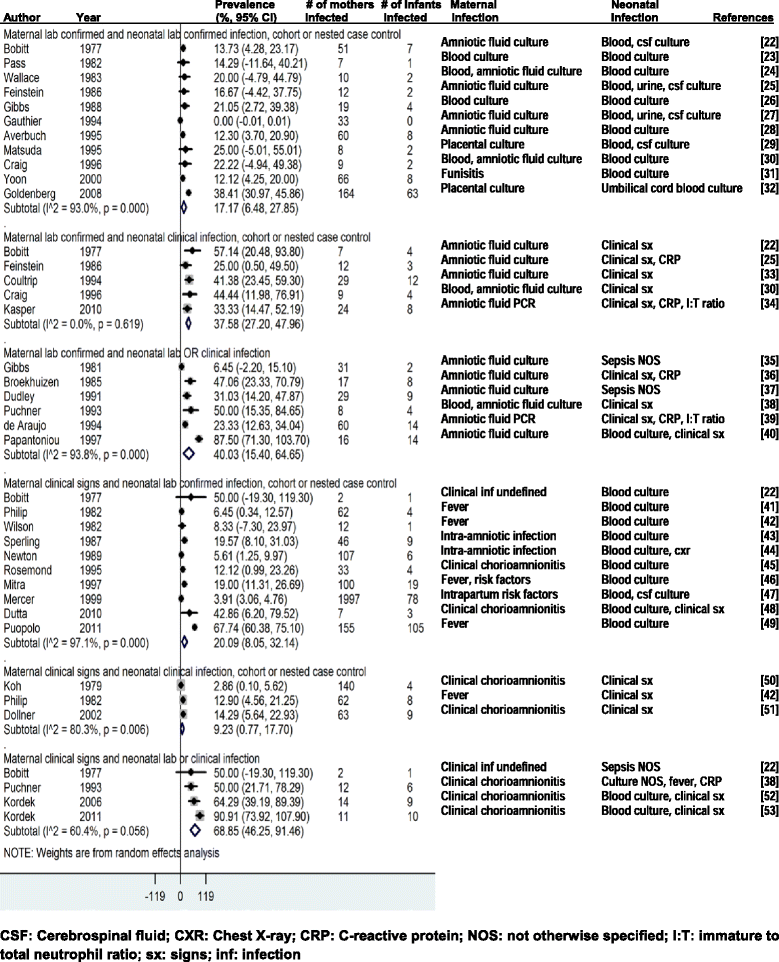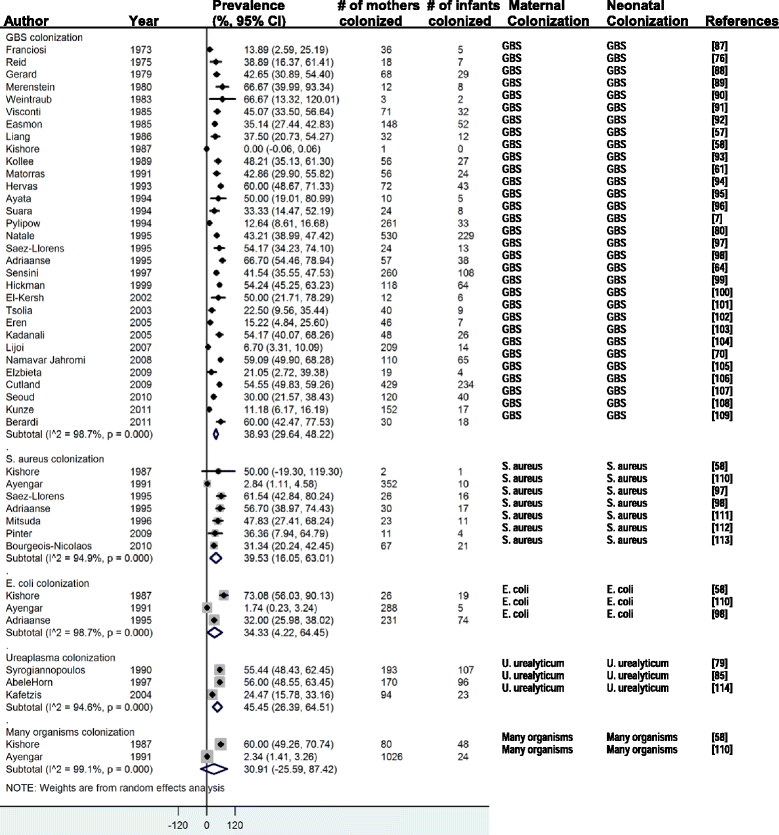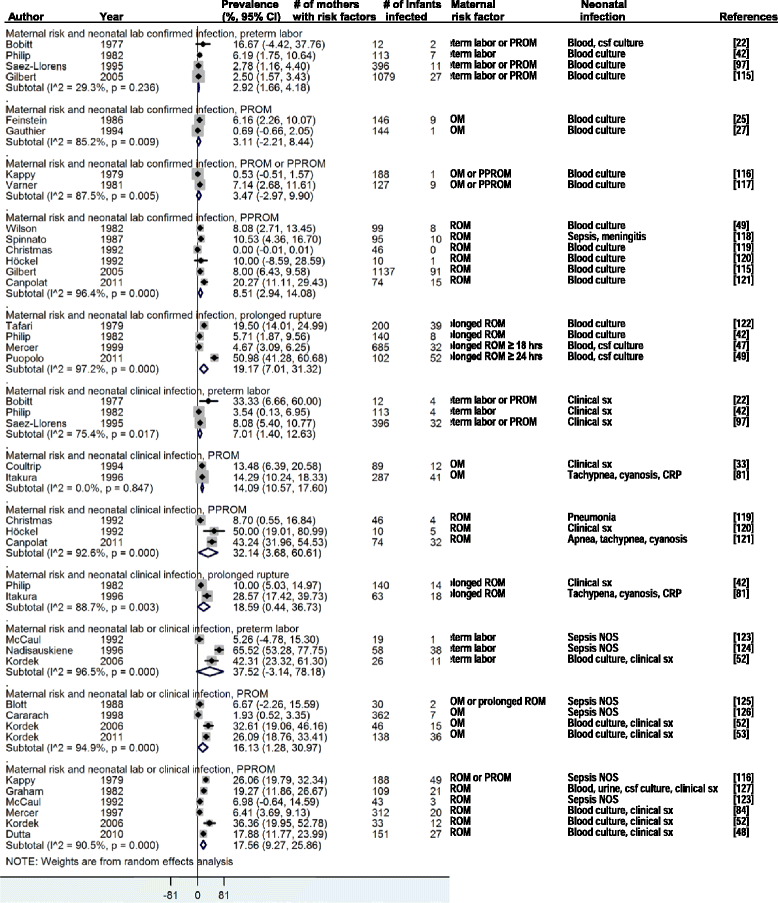Prevalence of early-onset neonatal infection among newborns of mothers with bacterial infection or colonization: a systematic review and meta-analysis
- PMID: 25886298
- PMCID: PMC4364328
- DOI: 10.1186/s12879-015-0813-3
Prevalence of early-onset neonatal infection among newborns of mothers with bacterial infection or colonization: a systematic review and meta-analysis
Abstract
Background: Although neonatal infections cause a significant proportion of deaths in the first week of life, little is known about the burden of neonatal disease originating from maternal infection or colonization globally. This paper describes the prevalence of vertical transmission--the percentage of newborns with neonatal infection among newborns exposed to maternal infection.
Methods: We searched Pubmed, Embase, Scopus, Web of Science, Cochrane Library, and WHO Regional Databases for studies of maternal infection, vertical transmission, and neonatal infection. Studies that measured prevalence of bacterial vertical transmission were included. Random effects meta-analyses were used to pool data to calculate prevalence estimates of vertical transmission.
Results: 122 studies met the inclusion criteria. Only seven studies (5.7%) were from very high neonatal mortality settings. Considerable heterogeneity existed between studies given the various definitions of infection (lab-confirmed, clinical signs), colonization, and risk factors of infection. The prevalence of early onset neonatal lab-confirmed infection among newborns of mothers with lab-confirmed infection was 17.2% (95%CI 6.5-27.9). The prevalence of neonatal lab-confirmed infection among newborns of colonized mothers was 0% (95% CI 0.0-0.0). The prevalence of neonatal surface colonization among newborns of colonized mothers ranged from 30.9-45.5% depending on the organism. The prevalence of neonatal lab-confirmed infection among newborns of mothers with risk factors (premature rupture of membranes, preterm premature rupture of membranes, prolonged rupture of membranes) ranged from 2.9-19.2% depending on the risk factor.
Conclusions: The prevalence of early-onset neonatal infection is high among newborns of mothers with infection or risk factors for infection. More high quality studies are needed particularly in high neonatal mortality settings to accurately estimate the prevalence of early-onset infection among newborns at risk.
Figures
References
-
- Baqui AH, Darmstadt GL, Williams EK, Kumar V, Kiran TU, Panwar D, Srivastava VK, Ahuja R, Black RE, Santosham M. Rates, timing and causes of neonatal deaths in rural India: implications for neonatal health programmes. Bull World Health Organ. 2006;84(9):706–713. doi: 10.2471/BLT.05.026443. - DOI - PMC - PubMed
-
- Seale AC, Blencowe H, Manu AA, Nair H, Bahl R, Qazi SA, Zaidi AK, Berkley JA, Cousens SN, Lawn JE, et al. Estimates of possible severe bacterial infection in neonates in sub-Saharan Africa, south Asia, and Latin America for 2012: a systematic review and meta-analysis. Lancet Infect Dis. 2014;14(8):731–741. doi: 10.1016/S1473-3099(14)70804-7. - DOI - PMC - PubMed
-
- Liu L, Johnson HL, Cousens S, Perin J, Scott S, Lawn JE, Rudan I, Campbell H, Cibulskis R, Li M, et al. Global, regional, and national causes of child mortality: an updated systematic analysis for 2010 with time trends since 2000. Lancet. 2012;379(9832):2151–2161. doi: 10.1016/S0140-6736(12)60560-1. - DOI - PubMed
-
- GNI per capita, Atlas method. [http://data.worldbank.org/indicator/NY.GNP.PCAP.CD]
-
- Global Burden of Disease Regions used for WHO-CHOICE Analyses. [http://www.who.int/choice/demography/regions/en/]
Publication types
MeSH terms
Grants and funding
LinkOut - more resources
Full Text Sources
Other Literature Sources
Medical
Miscellaneous






